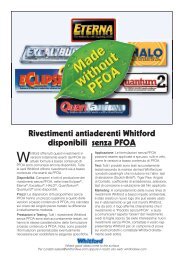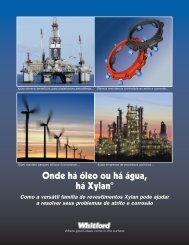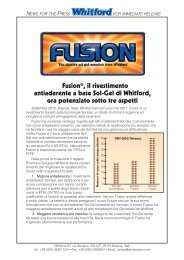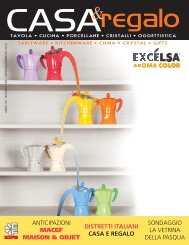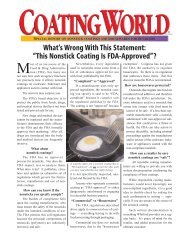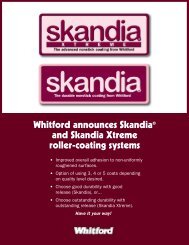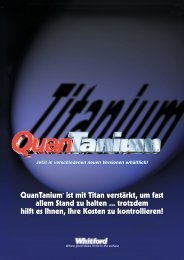Literature PDF
Literature PDF
Literature PDF
- No tags were found...
Create successful ePaper yourself
Turn your PDF publications into a flip-book with our unique Google optimized e-Paper software.
Xylan offers multiple benefits for oil rigs...Provides controlled friction and corrosion resistance...Xylan keeps wind farms running smoothly...Solves many problems at chemical processing plants...Where there’s oil, where there’s water,there’s Xylan ®How the versatile family of Xylan coatings can helpsolve your friction and corrosion problemsManufacturers of the world’s largest, most complete line of fluoropolymer coatings
We all learned in school that “oil andwater don’t mix”. But there is an importantexception to the rule: today’s versatileXylan coatings.This vast array of coatings, each designed tomeet a specific need (or needs) for fasteners,has been solving the same kinds of problems forthe oil as well as the waterworks industries (not tomention the chemical, automotive, energy andother industries) for nearly 40 years.OilThe corrosive elements of the environmentare responsible for today’s advanced coatings.Previously, fasteners were protected only byelectroplating, cadmium or zinc. But the protectionwas insufficient for the demands of the industry.(In addition, zinc coatings by themselvescause uneven, unpredictable results.)WaterThe waterworks industry, like many others,faces a disturbing increase in raw-material costs.That’s why nobody in the industry wants to paythe steep (and still climbing) price of fastenersmade of stainless steel. Further, stainless steelhas less yield strength than alloy steel, so a fastenercoated with Xylan not only offers greaterstrength but provides more accurate torque controlthan its stainless counterpart.In spite of this, some do pay the higher cost,generally because nobody wants to put an uncoatedsteel fastener in wet, hot soil, only to encounterrapid corrosion and the problems that causes.Enter Xylan coatingsXylan coatings solve as many problems forthe oil industry as they do for waterworks.Xylan offers fasteners such as T-Bolts controlledtorque, corrosion resistance and color-coding.For example:1. Controlled torque: Xylan coatings are engineeredwith PTFE for lubrication, which allowsprecise and uniform makeup torque. (Stainlesssteelfasteners are prone to galling.)2. Easy removal of nuts: The lubricity of Xylancoatings makes removal easy — even after manyyears. Coefficient of friction is as low as 0.055.3. Resistance to rust/corrosion: Steel fastenerscoated with Xylan over a zinc pretreatmentprovide corrosion resistance almost equal to thatof stainless steel. (They last as long as 2,500hours in ASTM B-117 salt-fog tests with less than15% red rust.)4. Resistance to galvanic corrosion: This occurswhen two metals far from one another on theelectromotive (galvanic) scale are joined by aconductor such as moisture. That frequently happenswhen stainless-steel fasteners are usedwith ductile iron, often employed in waterworkspipes and fittings. Xylan coatings reduce this corrosion.They also have a dielectric strength from500-1,200 volts per mil (which inhibits galvaniccorrosion).5. Eliminates the need for toxic lubricatingpaste: In fact, Whitford recommends not usingsuch pastes with Xylan-coated fasteners.6. Tough: Excellent resistance to wear, abrasion,chipping.7. Cost: Compared to stainless steel, Xylancoatings can save significant amounts (steel fastenerscoated with Xylan cost an average of 50%less than stainless-steel fasteners).8. Wide range of operating temperatures:Xylan coatings operate easily from -425˚F/-255˚Cto +550˚F/+290˚C.9. UV-stable: Some Xylan formulations havesuperb resistance to ultraviolet light.10. Resistance to hot soil: Xylan helps protectfasteners from corrosion caused by hot soils andmost common chemicals.11. Easily applied: Xylan can be applied byconventional spray, HVLP, electrostatic anddip/spin, making Xylan cost-effective for any sizeitem, from large fasteners to small 0-rings.12. Remarkable adhesion: It adheres to avariety of substrates, including steel, aluminum,copper, stainless steel, brass, titanium.13. Color-coding: Xylan is easily color-codedfor specific applications (to avoid confusion).14. FDA-acceptable: Many Xylan coating formulationscomply with Food & Drug Administra-
Why settle for this...tion regulations for food contact.Surface preparationXylan coatings (or any thin-film coating) cannotby themselves provide complete corrosionprotection. For maximum performance, primersor pretreatments are required. The best are:• Microcrystalline, heat-stable zinc or manganesephosphate conversion coating• Xylan 4000 Series primers (ask Whitford)• Commercial plating, zinc, cadmium andaluminum pretreatments• Xylar 2 or P51 (ceramic metallics).Types of corrosion-mitigating coatingsThese fall into three common categories, allof which Whitford offers: barrier, inhibitive andsacrificial.A barrier coating stands between the metalfastener and the environment. This is usually anorganic coating with fillers that help stop moistureor vapor from permeating the film to themetal and becoming an electrolyte.An inhibitive coating is usually an organiccoating with corrosion inhibitors, such as zincphosphates, chromates, and many more. In additionto acting as barriers, they help prevent corrosionby using pigments that provide an inhibitiveeffect, reacting with the absorbed moisture in thecoating, then reacting with the steel to passivateit and decrease its corrosive characteristics.A sacrificial coating is usually a metal or inorganiccoating containing metal particles (oftenzinc). If the coating is damaged, they act as asacrificial anode and corrode to protect the steel...when you can have this?substrate, sacrificing themselves by galvanic action.These can also be electroplated like zinc orcadmium.The coating options1000 series general-purpose coatings1014 and 1070 were the first Xylan fastenercoatings, introduced in the mid-1970s and stillgoing strong. They provide outstanding lubricationfor predictable makeup and break-out torque,and they have outstanding chemical resistance.Another advantage: They tolerate temperaturesfrom -425˚F/-255˚C to +550˚F/+290˚C continuously.Xylan 1070 has added corrosion inhibitors.1400 series coatingsThe 1400 series is the hand-spray version ofthe Xylan 5000 series dip/spin products (more onthese later). The 1400 series does not have quitethe wide temperature range of the 1000 series,although they have nearly three times the corrosionresistance applied over any given pretreatment.Xylan 1400 series coatings can be made inany color, including white. They also have betterchemical resistance to bases than the 1000 series.Xylan 1400 series reaches complete cure at400˚F/205˚C, ideal for most coating operations.Xylan 1400 series coatings work best for onetimeinstallations, where the fastener will becoated, installed, and left alone.142X series coatingsXylan 1424 and 1427 are the environmentallyfriendlier combination of the 1000 and 1400 seriescoatings, combining the best of both. Xylan142X coatings have all the chemical resistance of
LoadincreasesRelationship ofLoad to TorqueXylanCadmium/WaxBlack/OilTorque increasesWhitford recommends the use of direct-tension indicators(DTIs) to determine proper makeup torque for eachsize or lot of fasteners used on a given application.the 1400 series with the lubricant levels of the1000 series products. However, the 142X seriesproducts do not have the wide temperaturerange, performing best between -40˚F/-40˚C to+350˚F/+175˚C.5000 series dip/spin coatingsThese have all the attributes of their handspraycousins, except that they are formulatedfor application via dip/spin equipment. Xylan5000 series products are specified for fastenersby the major automotive companies, buildingconstructors and appliance manufacturers.Achieving uniform torqueFluoropolymer coatings have the lowest coefficientof friction of all known fastener coatings,which requires that “makeup torque”specification be adjusted to compensate.Many factors affect the determination of theideal torque value to achieve recommendedclamping loads (K-factor). The coefficient offriction (CoF) is only one. The K (or nut) factorvaries, since it is the net effect of many variablessuch as type of fastener, thread, threadangle, type of pretreatment, etc. It would be inappropriatefor Whitford to offer K-factor informationwhen Xylan is only one of the manyvariables involved. The same lot of Xylan 1424applied to different types of fasteners can resultin a reduction of makeup torque from 30 all theway to 70 percent, caused by the differences infasteners. Note: Makeup torque will not vary onfasteners of the same size and make.Every bolted joint is unique, andthe optimum tightening torque shouldbe determined for each by carefultesting. A properly tightened bolt isstretched so that it acts like a rigidspring, pulling the mating surfacestogether. Whitford recommends a direct-tension(load-cell) study forevery size and type of fastener youare using, routine practice in the constructionindustry.Another option is to use Fastorq’sBoltcalc software. Fastorq, of Houston,Texas, has performed this directtensionstudy on many types offasteners with many types of coatings,including Xylan. They have putthis information in a program calledBoltcalc (fastorq.com/products/boltcalc.cfm),which is available for purchase.We also recommend that youuse direct-tension-indicating washers (DTIs) onrandom connections to double-check the theoreticalvalues.Physical/chemical propertiesCorrosion comes in many forms: atmospheric,galvanic, chemical, fretting, salt-fog, etc.Stainless steel needs oxygen to provide anoxide layer that inhibits corrosion. So it wouldnot be fair to compare Xylan to stainless steel inan ASTM B-117 salt-fog test when the end useis buried in hot soil. Of course stainless steelwill outperform Xylan in the salt-fog test, althoughXylan will outperform stainless steelwhen buried in hot soil.In coastal environments, stainless steel issusceptible to chloride-induced stress-corrosioncracking (chemical corrosion). Xylancoatedcarbon-steel bolts are not affected bychlorides.Stainless-steel fasteners also gall and seize.It is common knowledge that stainless-steel fastenersneed to be retorqued after 24 hours dueto galling, losing up to 40% of their clampingforce in 24 hours. But Xylan-coated carbonsteelfasteners reach the required clamp loadon the first makeup.When stainless steel is combined with dissimilarmetals, galvanic corrosion results. Xylancoatedcarbon steel in combination with anyalloy does not lead to galvanic corrosion.Perhaps the most striking difference of all is
that stainless-steel fasteners can cost twice asmuch as Xylan-coated carbon-steel fasteners.A few suggestionsWhitford recommends the use of Whitfordapprovedfastener-class coating applicators,highly trained experts in the application of pretreatments,Whitford primers and coatings.Further, with today’s emphasis on quality(such as ISO 9001-2000), Whitford urges thatall end users ask for and keep a record of thelot number of the Xylan coating used. This, withthe fastener certification document, ensurestraceability should there be a problem.For more information, contact your Whitfordrepresentative (or sales@whitfordww.com) andask for our “Guide to Industrial Products”, “Howto Reduce Friction with Xylan” and “9 DangerousMisconceptions about Xylan 1000 series”.Examples of the Chemical Resistance of Xylan CoatingsChemicalXylan 1014HCl (concentrated) Severe blisters, rustat room temperature (1)HCl (pH 2) at room Slight markstemperature (1)HCl (pH 2) at 125˚F (1) Slight marksNaOH (50%) at room Severe failure,temperature (1)blistersNaOH (pH 12.5) (1) Severe failure,blistersNaOH (pH 9.5) atSlight marksroom temperature (1)NaOH (pH 9.5) at 125˚F (1) Slight marksMEK at roomSlight markstemperature (1)Toluene at roomSlight markstemperature (1)Ethylene glycol at room No effecttemperature (1)Salt spray for 1488 20% red rust,hoursadhesion lossKesternich4 cycles, 20+%, redrust, adhesion lossCastrol Hydraulic Fluid Not recommendedat 200˚F (2)W. Canning Oceanic Not recommendedHK-540 at 200˚F (2)(1) = 24-hour chemical spot tests (ASTM D1308-79)(2) = Immersion testsXylan 1400Severe blisters, rustSlight marksSlight marksNo effectNo effectNo effectVery slight marksSlight marksSlight marksNo effect15% red rust, denseedge blistering30 cycles, 1% redrust, blisteringGloss decrease,no loss in coatingintegrityGloss decrease,no loss in coatingintegrity, slightcolor lighteningXylan 1424No effectNo effectNo effectNo effectNo effectNo effectNo effectSlight marksSlight marksNo effect
Whatever your coating problem,Whitford probably has the rightproduct to solve it. If not, we willwork closely with you todevelop the coating that will.How to contact WhitfordWhitford manufactures and maintains sales offices in manycountries of the world. For more information, please contactyour Whitford representative or the nearest Whitford office (seeour website: whitfordww.com) or sales@whitfordww.com.Xylan ® and Xylar ® are registered trademarks of Whitford.Manufacturers of the world’s largest, most complete line of fluoropolymer coatingsNON-WARRANTY: THE INFORMATION PRESENTED IN THIS PUBLICATION IS BASED UPON THE RESEARCH AND EXPERIENCE OFWHITFORD. NO REPRESENTATION OR WARRANTY IS MADE, HOWEVER, CONCERNING THE ACCURACY OR COMPLETENESS OFTHE INFORMATION PRESENTED IN THIS PUBLICATION. WHITFORD MAKES NO WARRANTY OR REPRESENTATION OF ANY KIND,EXPRESS OR IMPLIED, INCLUDING WITHOUT LIMITATION ANY WARRANTY OF MERCHANTABILITY OR FITNESS FOR ANY PARTICU-LAR PURPOSE, AND NO WARRANTY OR REPRESENTATION SHALL BE IMPLIED BY LAW OR OTHERWISE. ANY PRODUCTS SOLD BYWHITFORD ARE NOT WARRANTED AS SUITABLE FOR ANY PARTICULAR PURPOSE TO THE BUYER. THE SUITABILITY OF ANY PROD-UCTS FOR ANY PURPOSE PARTICULAR TO THE BUYER IS FOR THE BUYER TO DETERMINE. WHITFORD ASSUMES NO RESPONSI-BILITY FOR THE SELECTION OF PRODUCTS SUITABLE TO THE PARTICULAR PURPOSES OF ANY PARTICULAR BUYER. WHITFORDSHALL IN NO EVENT BE LIABLE FOR ANY SPECIAL, INCIDENTAL OR CONSEQUENTIAL DAMAGES.© Whitford 2009/WC4/09



